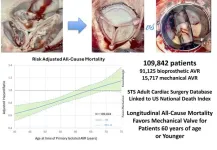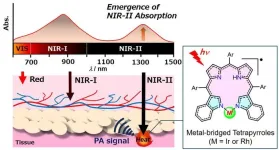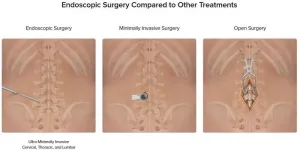(Press-News.org) LOS ANGELES —January 26, 2024 — Young patients who have undergone the Ross procedure for aortic valve disease have shown excellent long-term survival, the majority without the need for additional surgery two decades later.
These findings, presented today at the 61st annual meeting of The Society of Thoracic Surgeons (STS), were the result of a 22-year study at the Narayana Institute of Cardiac Sciences in Bengaluru, India.
“The Ross operation can be performed safely with results comparable to mechanical valve replacement,” said the study’s lead author, cardiac surgeon Varun Shetty, MBBS, DNB (CVTS). “It has the added advantage of avoiding oral anticoagulation drugs and the risks associated with lifelong anticoagulation. In fact, most of our patients are not on any cardiac medications following one year after surgery.”
Dr. Shetty’s team followed 252 patients who underwent the Ross procedure, a heart valve replacement operation commonly used to treat younger patients with severe aortic valve disease. During the surgery, the malfunctioning aortic valve is replaced with the patient’s own healthy pulmonary valve—a technique called an autograft—and the pulmonary valve replaced with donor tissue.
“The main drawback of the Ross operation is failure of the autograft over time,” Dr. Shetty said. “We wanted to examine our outcomes, and we were pleasantly surprised to find that the freedom from re-intervention was 91% at 10 years and 87% at 20 years.”
Of the 252 patients in the study, 186 underwent a cylinder inclusion technique, or “mini root” replacement, while 25 received a Dacron-reinforced autograft. Three patients underwent the Ross-Konno procedure, in which the left-sided outflow root is enlarged to fit the pulmonary autograft. Twenty-five patients also received an ascending aorta replacement, two received hemiarch replacement, and four underwent septal myectomy—removal of abnormally thickened heart muscle.
At follow-up, Dr. Shetty’s team found that survival rates were 95.8% at 5 years, 94.3% at 10 years, 93.3% at 15 years, and 90.3% at 20 years. “Freedom from aortic regurgitation was 95.1%, 92.2%, 87.7%, and 84.5% at 5,10,15 and 20 years respectively,” the researchers reported.
Freedom from pulmonary regurgitation was lower—97% at 5 years, 83.6% at 10 years, 79.7% at 15 years, and 75.1% at 20 years.
“Individuals aged 18 years or younger exhibit notably higher rates of aortic regurgitation,” Dr. Shetty observed. “Risk factors for late autograft dysfunction include a dilated aortic annulus and ascending aorta.”
“Stabilization of the aortic annulus and pulmonary autograft will improve the re intervention rate in the future,” he added.
Because the Ross procedure uses living tissue, it not only can circumvent the need for anticoagulant medication, but also allows the valves to grow along with a growing child.
“The most important message from our study is that the Ross procedure offers excellent long-term survival rates with low risk of re-intervention even at 20 years,” Dr. Shetty said. “This makes the Ross operation an excellent substitute for mechanical valve replacement.”
Dr. Shetty’s team benchmarked their results with those recorded in the STS Congenital Heart Surgery Database (CHSD)—which contains more than 600,000 congenital heart surgery procedure records and currently has more than 1,000 participating physicians, including surgeons and anesthesiologists.
“Our study, performed at a single high-volume surgical center in India, demonstrates that the Ross operation can be performed with reproducible success across the globe,” Dr. Shetty said.
The CHSD is part of the STS National Database, one of the largest and most comprehensive clinical registries with nearly 10 million cardiothoracic procedures performed by 4,300+ surgeons. With over 95% of adult and congenital cardiac surgery procedures and a majority of lung cancer and esophageal cancer surgery in the U.S., the data and outcomes from the STS Database specialty registries provide true national benchmarks for clinical outcomes of cardiothoracic surgery.
# # #
About STS
Founded in 1964, The Society of Thoracic Surgeons is a not-for-profit organization representing more than 7,800 cardiothoracic surgeons, researchers, and allied healthcare professionals worldwide who are dedicated to ensuring the best possible outcomes for surgeries of the heart, lung, and esophagus, as well as other surgical procedures within the chest. The Society’s mission is to improve the lives of patients with cardiothoracic diseases.
END
LOS ANGELES—January 26, 2025—As contemporary surgical practice continues to evolve, patients who undergo surgical lung volume reduction (LVRS) for advanced emphysema may survive longer and with fewer complications than they did in the past—and they may even fare better than those who opt for endobronchial valve (EBV) placement.
At the 2025 Society of Thoracic Surgeons (STS) Annual Meeting, researchers presented risk-adjusted findings that shed new light on treatments for severe emphysema. Despite having shorter hospital stays, lower hospital ...
LOS ANGELES—January 25, 2025—A late-breaking study presented today at the 2025 Society of Thoracic Surgeons (STS) Annual Meeting reveals that mechanical aortic valve replacements (AVRs) provide significant long-term survival benefits for patients aged 60 and younger compared to bioprosthetic valves. The study, leveraging data from the STS Adult Cardiac Surgery Database (ACSD), offers the most comprehensive analysis to date of prosthetic valve outcomes, encompassing over 100,000 patients.
The study addressed a critical question ...
LOS ANGELES—January 25, 2025 New research presented at the 2025 Society of Thoracic Surgeons (STS) Annual Meeting reveals that anatomic lung resections, such as lobectomy and segmentectomy, are associated with improved long-term survival compared to wedge resection for patients with early-stage non-small cell lung cancer (NSCLC).
The study analyzed outcomes for more than 32,000 stage 1A NSCLC patients using data from the STS General Thoracic Surgery Database (STS GTSD) with long-term follow-up linked to the National Death Index and Centers ...
SAN FRANCISCO – Patients with metastatic colorectal cancer (mCRC) harboring BRAF V600E mutations benefitted from first-line treatment with the targeted therapies encorafenib and cetuximab plus a mFOLFOX6 chemotherapy regimen, according to results from the Phase III BREAKWATER trial led by researchers at The University of Texas MD Anderson Cancer Center.
The findings, presented today at the American Society of Clinical Oncology Gastrointestinal Cancers (ASCO GI) Annual Symposium and published in Nature Medicine, demonstrated a 60.9% overall response rate (ORR) with the three-drug combination ...
Boston – A data analysis from a randomized clinical trial for stage 3 colon cancer patients by investigators at Dana-Farber Brigham Cancer Center found that patients with evidence of residual cancer in their blood after surgery to remove the cancer, may benefit from adding of celecoxib, to post surgery treatment. The analysis showed that patients with positive blood tests for circulating tumor DNA (ctDNA) had worse outcomes in general, but those who were treated with celecoxib, a non-steroidal anti-inflammatory drug, experienced significantly improved disease-free survival.
“This is one of the first studies to show that ctDNA status has predictive utility in terms of selecting ...
The Alliance for Clinical Trials in Oncology today announced the results of a data analysis from a randomized phase III clinical trial involving patients with stage III colon cancer, which found that adding the drug celecoxib to treatment after surgery might help those who still have traces of cancer in their blood. The analysis showed that patients with signs of cancer in their blood measured by Signatera™, a circulating tumor DNA (ctDNA) test, tended to have worse outcomes. However, those who took celecoxib after surgery had a much better chance of staying cancer-free. These results are being presented in a late-breaking ...
Tokyo, Japan – Researchers from Tokyo Metropolitan University have developed a new dye that can strongly absorb second near-IR radiation and transform it to heat. Starting with a dye from the bile pigment family, they designed a unique ring structure which can bind rhodium and iridium. Measurements and modeling revealed strong second near-IR absorptions and exceptional photostability. Second near-IR waves easily penetrate human tissue; the new dye may be applied in deep tissue therapies and imaging.
The second near-IR region of the electromagnetic spectrum (1000-1700 nanometers) ...
Researchers at the University of Colorado Anschutz Medical Campus have found a promising drug candidate that could help restore vision in individuals with multiple sclerosis (MS) and other neurological conditions that damage neurons.
The study was published this week in the journal Nature Communications.
The drug, LL-341070, enhances the brain's ability to repair damaged myelin— the protective sheath around nerve fibers. Damage to myelin is a hallmark of diseases like MS, as well as a natural consequence of aging, often resulting in vision loss, loss of motor skills, ...
Complex organisms, thousands of times smaller than a grain of sand, can shape massive ecosystems and influence the fate of Earth's climate, according to a new study.
Researchers from Arizona State University, along with their colleagues from the National University of the Peruvian Amazon, have identified an unknown family of microbes uniquely adapted to the waterlogged, low-oxygen conditions of tropical peatlands in Peru’s northwestern Amazonian rainforest.
The new research shows these microbes have a dual role in the carbon cycle and the potential to either ...
CLEVELAND – University Hospitals is now offering endoscopic spine surgery for patients needing treatment for back pain due to herniated discs in their spine. Xiaofei (Sophie) Zhou, MD, completed Arthrex's Endoscopic Spine Training course to bring this advanced procedure to the health system and recently completed the first endoscopic discectomy utilizing Arthrex technology at UH. The health system is the only one in the greater Cleveland area offering this type of ultra-minimally invasive surgery.
Arthrex's technology allows surgeons to remove the ...





